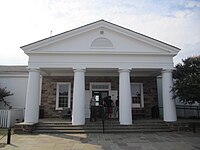Manassas National Battlefield Park
| Manassas National Battlefield Park | |
|---|---|
IUCN category V (protected landscape/seascape) | |
| File:Stonewall Jackson Memorial in Manassas Battlefield Park.jpg General Thomas "Stonewall" Jackson statue at Manassas National Battlefield Park | |
| Lua error in Module:Location_map at line 526: Unable to find the specified location map definition: "Module:Location map/data/USA relief" does not exist. | |
| Location | Prince William County, Virginia |
| Nearest city | Manassas, Virginia |
| Area | 5,073 acres (20.53 km2) |
| Established | May 10, 1940 |
| Visitors | 715,622 (in 2005) |
| Governing body | National Park Service |
Manassas National Battlefield Park | |
| NRHP reference No. | 66000039[1] |
| Added to NRHP | October 15, 1966 |




Manassas National Battlefield Park, located north of Manassas, in Prince William County, Virginia, preserves the site of two major American Civil War battles: the First Battle of Bull Run on July 21, 1861, and the Second Battle of Bull Run which was fought between August 28 and August 30, 1862 (also known as the First Battle of Manassas and the Second Battle of Manassas, respectively). The peaceful Virginia countryside bore witness to clashes between the armies of the North (Union) and South (Confederacy), and it was here that Confederate General Thomas J. Jackson acquired his nickname "Stonewall."
Today the National Battlefield Park provides the opportunity for visitors to explore the historic terrain where men fought and died more than a century ago. More than 900,000 people visit the battlefield each year. (In comparison, roughly 15 million people annually visit nearby Washington, DC.[2]) As an historic area under the National Park Service, the park was administratively listed on the National Register of Historic Places on October 15, 1966.
The Henry Hill Visitor Center, on Sudley Road by the south entrance to the park, offers exhibits and interpretation regarding the First Battle of Bull Run, including civil war era uniforms, weapons, field gear and an electronic battle map. The center offers the orientation film "Manassas: End of Innocence", as well as a bookstore.
Historic Sites to see on Battlefield
1. Stone House, used as a hospital during both battles. It is near the intersection of Sudley Road and Lee Highway.
2. Stone Bridge, which the Union retreated across after both battles. It crosses just north of Lee Hyway at the Fairfax-Prince William Co. line.
3. Brawner's Farm, the opening phase of the second battle. The parking lot is off of Pageland Lane at the western edge of the battlefield. It has recently been renovated to become a museum dedicated to the Second Battle of Bull Run.
4. Battery Heights, where Confederate batteries were deployed to fire on the attacking Union troops at nearby Brawner's Farm. It is off of Lee Highway.
5. Matthews Hill, the opening phase of the 1st battle. It is off of Sudley Road.
6. The Unfinished Railroad Grade, where Jackson deployed his men before the second battle after capturing Pope's supply depot. Off of Featherbed Lane.
7. The Deep Cut, where Pope launched the bulk of his attacks against the Grade. Off of Featherbed Lane, before you reach the Railroad Grade.
8. Groveton, an extinct Civil War era village. All that remains is the small frame house that Lucinda Dogan lived in. A Confederate Cemetery is nearby. Both are off Lee Highway.
9. New York Monuments, two monuments dedicated to the 5th and 10th NY Reg'ts. These mark where the 5th New York Zouaves lost 123 men in 5 minutes in the advance of Hood's men; off of Lee Highway, near Young's Branch on 5th New York Avenue and cross from the Confederate cemetery at Groveton.
10. Hazel Plain, the plantation of the Chinn family. It now sits in ruins, and only the foundation remains. Directly across from the Henry Hill Visitors Center.
11. Chinn Ridge, across from Hazel Plain. General James Longstreet's massive counterattack during the 2nd battle took place here. A trail leads to a boulder for Union Colonel Fletcher Webster, the son of the famous orator Daniel Webster, who was killed leading a failed attempt at repulsing the Confederate Counterattack.
12. Portici, the plantation of Francis Lewis, now in ruins. This served as the Confederate Headquarters during the 2nd battle, and on the plains surrounding it minor skirmishes between companies.
13. Robinson House, now in ruins (lost to arson in the 1993), was the home of freed slave James Robinson. It is on the Henry Hill Loop Trail, Walking only. It is not accessible to cars.
See also
References
- The National Parks: Index 2001-2003. Washington: U.S. Department of the Interior.
- Survey No. HABS VA-144. Historic American Buildings Survey.
- http://www.nps.gov/mana/planyourvisit/upload/park%20map.pdf
External links
- National Park Service: Manassas National Battlefield Park
- First Battle of Manassas: An End to Innocence, a National Park Service Teaching with Historic Places (TwHP) lesson plan
Notes
- IUCN Category V
- Battlefields of the Eastern Theater of the American Civil War
- Parks in Virginia
- National Battlefields and Military Parks of the United States
- Prince William County in the American Civil War
- National Register of Historic Places in Prince William County, Virginia
- United States National Park Service areas in Virginia
- Museums in Prince William County, Virginia
- Protected areas established in 1940
- American Civil War museums in Virginia
- Parks in Prince William County, Virginia
- Reportedly haunted locations in the United States
- Journey Through Hallowed Ground National Heritage Area
- National Register of Historic Places in Fairfax County, Virginia
